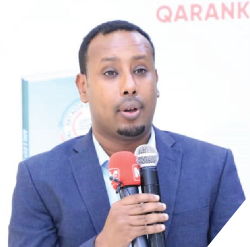South Sudan
PEACE AND STABILITY KEY FOR SOUTH SUDAN’S ECONOMIC TURNAROUND
 South Sudan’s fiscal deficit is expected to improve to
about 2.7 percent of GDP in the 2021/2022 financial year,
the World Bank Group reports. This reflects a higher
than projected oil and non-oil revenue for the oil-rich
nation, and the impact of ongoing financial consolidation
efforts. In addition, the country’s current account
deficit is expected to narrow to 7.1 percent of GDP, from
the previous 7.9 percent. This follows a financial year
that was marked by slow growth, resulting from effects
of the COVID-19 pandemic, lower oil production, floods,
and intensified conflict in parts of the country.
South Sudan’s fiscal deficit is expected to improve to
about 2.7 percent of GDP in the 2021/2022 financial year,
the World Bank Group reports. This reflects a higher
than projected oil and non-oil revenue for the oil-rich
nation, and the impact of ongoing financial consolidation
efforts. In addition, the country’s current account
deficit is expected to narrow to 7.1 percent of GDP, from
the previous 7.9 percent. This follows a financial year
that was marked by slow growth, resulting from effects
of the COVID-19 pandemic, lower oil production, floods,
and intensified conflict in parts of the country.
Although South Sudan has consistently returned increased agricultural production in recent times, exceptionally high food prices continue to constrain access to food for large segments of its population. The positive country outlook depends on peace and stability, sustained commitment to economic and public finance management reforms, improved budgeting and allocation of resources, and stabilisation of smallholder agriculture. If achieved, food security, and accordingly, the living conditions of about 8.3 million South Sudanese currently on humanitarian assistance will improve.
Women constitute about 70 percent of South Sudan’s informal traders doing business with neighbouring Uganda, the Democratic Republic of Congo, Ethiopia, Sudan and Kenya. TradeMark East Africa (TMEA) – South Sudan is working with these businesswomen to increase their incomes, and boost their capacity to access trade information and market intelligence, and advocate for an improved business environment, for posterity. In the year under review, 2005 women traders were trained on business management skills, marketing, and export trade in Nimule, Nadapal and Kaya, respectively.
Other interventions that enhanced business continuity included distribution of Personal Protective Equipment (PPE) to cross-border traders and border officials, and training on safety protocols. This was done under the auspices of TMEA’s Safe Trade Emergency Facility Programme which was developed to help Eastern African Governments mitigate the spread of COVID-19 and ensure safe continuity of trade.
Catherine Ssekimpi,
Ag. Country Representative
 The European Union’s Ethiopia’s resilience is doubtless; confronting a dynamic
political environment that’s compounded by COVID-19
pandemic, and protracted political conflict, yet incorporating
the private sector to ensure socio-economic
progress. It is noteworthy that Ethiopia held elections
in June and September 2021, in which the incumbent
Prime Minister, Abiy Ahmed, got re-elected for another
five years. However, the country has faced political instability
thereafter.
The European Union’s Ethiopia’s resilience is doubtless; confronting a dynamic
political environment that’s compounded by COVID-19
pandemic, and protracted political conflict, yet incorporating
the private sector to ensure socio-economic
progress. It is noteworthy that Ethiopia held elections
in June and September 2021, in which the incumbent
Prime Minister, Abiy Ahmed, got re-elected for another
five years. However, the country has faced political instability
thereafter. In 2018, TradeMark East Africa (TMEA) expanded its operations
to the Horn of Africa, covering Ethiopia, Somaliland
and Djibouti. The Horn of Africa Programme aims at
improving competitiveness of trade and transport along
the Berbera Corridor, resulting in reduced cost and time
for doing business.
In 2018, TradeMark East Africa (TMEA) expanded its operations
to the Horn of Africa, covering Ethiopia, Somaliland
and Djibouti. The Horn of Africa Programme aims at
improving competitiveness of trade and transport along
the Berbera Corridor, resulting in reduced cost and time
for doing business. As COVID-19 ravaged the world, compromising human health
and socio-economics of societies, the Government of Kenya
established a multi-sectoral national coordination committee,
with representatives from Public and Private sector, and
a mandate to respond and create a recovery plan beyond
COVID-19. The committee developed a Rapid Economic
Stimulus Programme, and the Post-COVID-19 Economic
Recovery Strategy, which have, among others, helped sustain
the country’s vision of job creation, better income and poverty
elimination, and Industrialisation.
As COVID-19 ravaged the world, compromising human health
and socio-economics of societies, the Government of Kenya
established a multi-sectoral national coordination committee,
with representatives from Public and Private sector, and
a mandate to respond and create a recovery plan beyond
COVID-19. The committee developed a Rapid Economic
Stimulus Programme, and the Post-COVID-19 Economic
Recovery Strategy, which have, among others, helped sustain
the country’s vision of job creation, better income and poverty
elimination, and Industrialisation. Rwanda’s rapid, systematic, and comprehensive approach
to containing COVID-19 was widely praised, as the country
became the first in East Africa to impose a nationwide lockdown
and install handwashing-stations and temperature
checks in all public spaces.
Rwanda’s rapid, systematic, and comprehensive approach
to containing COVID-19 was widely praised, as the country
became the first in East Africa to impose a nationwide lockdown
and install handwashing-stations and temperature
checks in all public spaces. The Technical Assistance Agreement between the
Government of Malawi and TradeMark East Africa (TMEA)
was signed in mid-August 2020, setting the stage for
the Safe Trade Emergency Facility Programme (Safe
Trade), which helped stave off severe repercussions of
COVID-19 on trade. Business performance in Malawi had
by early 2021 shown improvement, with 46 percent of
firms surveyed by the Malawi Confederation of Chamber
of Commerce and Industry (MCCCI) in February 2021
indicating they expect positive performance for the year.
The Technical Assistance Agreement between the
Government of Malawi and TradeMark East Africa (TMEA)
was signed in mid-August 2020, setting the stage for
the Safe Trade Emergency Facility Programme (Safe
Trade), which helped stave off severe repercussions of
COVID-19 on trade. Business performance in Malawi had
by early 2021 shown improvement, with 46 percent of
firms surveyed by the Malawi Confederation of Chamber
of Commerce and Industry (MCCCI) in February 2021
indicating they expect positive performance for the year. Burundi approaches its 60th anniversary of independence,
next year, with a little more than hope for a better political and
socio-economic future. The country has made some strides
towards fostering internal “peace, security, stability and social
cohesion”, as well as in restoring old, and building new diplomatic
relations. Not only has Burundi made effort to firm up its
relationships with fellow East African Community (EAC) Partner
States, but it has also shown cordiality and goodwill to other
countries, including South Africa, Ethiopia, Equatorial Guinea,
Egypt, China, and the European Union (EU). These efforts
augur well for the country’s policy priorities, particularly alleviating
growth bottlenecks and supporting the private sector,
and continuing to strengthen transparency and governance.
Burundi approaches its 60th anniversary of independence,
next year, with a little more than hope for a better political and
socio-economic future. The country has made some strides
towards fostering internal “peace, security, stability and social
cohesion”, as well as in restoring old, and building new diplomatic
relations. Not only has Burundi made effort to firm up its
relationships with fellow East African Community (EAC) Partner
States, but it has also shown cordiality and goodwill to other
countries, including South Africa, Ethiopia, Equatorial Guinea,
Egypt, China, and the European Union (EU). These efforts
augur well for the country’s policy priorities, particularly alleviating
growth bottlenecks and supporting the private sector,
and continuing to strengthen transparency and governance.  The 2020/2021 financial year bore a mixed basket of fortunes
for Tanzania. With the untimely demise of Dr. John
Pombe Magufuli, Tanzania’s 5th President, in March 2021,
the country exercised a peaceful transfer of powers to
the then Vice President, Hon. Samia Suluhu Hassan, now
the 6th President of the United Republic of Tanzania. At
the onset of the pandemic, there were minimal business
disruptions, with some sectors, specifically horticulture,
registering increased trade activities and volumes. During
this time, Tanzania lowered its monetary policy rate to
5 percent from the previous 7 percent, to better accommodate
and support credit and economic growth targets.
Similarly, the price of food was lowered, leading to a
drop-in inflation rate to 3.3percent from 3.5 percent in
the previous year. It is noteworthy that Tanzania’s fiscal
deficit also remained lower than the government’s 5 percent
target, increasing minimally to 2.3 percent from 2
percent of GDP.
The 2020/2021 financial year bore a mixed basket of fortunes
for Tanzania. With the untimely demise of Dr. John
Pombe Magufuli, Tanzania’s 5th President, in March 2021,
the country exercised a peaceful transfer of powers to
the then Vice President, Hon. Samia Suluhu Hassan, now
the 6th President of the United Republic of Tanzania. At
the onset of the pandemic, there were minimal business
disruptions, with some sectors, specifically horticulture,
registering increased trade activities and volumes. During
this time, Tanzania lowered its monetary policy rate to
5 percent from the previous 7 percent, to better accommodate
and support credit and economic growth targets.
Similarly, the price of food was lowered, leading to a
drop-in inflation rate to 3.3percent from 3.5 percent in
the previous year. It is noteworthy that Tanzania’s fiscal
deficit also remained lower than the government’s 5 percent
target, increasing minimally to 2.3 percent from 2
percent of GDP. The African Development Bank projects a favourable economic
outlook for the Democratic Republic of Congo (DRC)
for 2021 and 2022 if the COVID-19 pandemic is brought under
control and global demand for exports recovers. DRC is among
countries with the least COVID-19 testing and vaccine uptake
rates, due to rampant myths surrounding the disease. This
combined with insecurity in Eastern DRC made implementation
of programmes particularly challenging.
The African Development Bank projects a favourable economic
outlook for the Democratic Republic of Congo (DRC)
for 2021 and 2022 if the COVID-19 pandemic is brought under
control and global demand for exports recovers. DRC is among
countries with the least COVID-19 testing and vaccine uptake
rates, due to rampant myths surrounding the disease. This
combined with insecurity in Eastern DRC made implementation
of programmes particularly challenging.